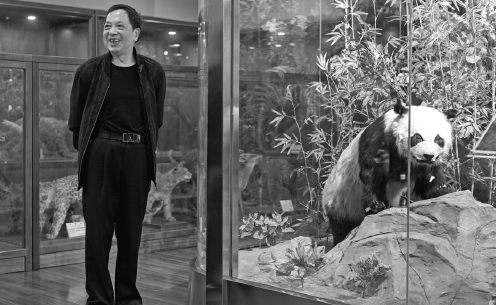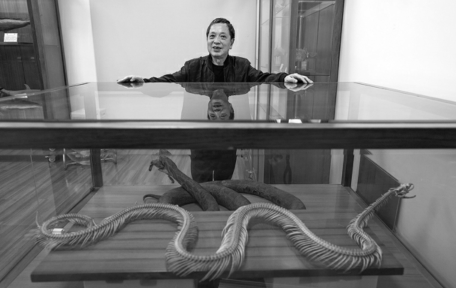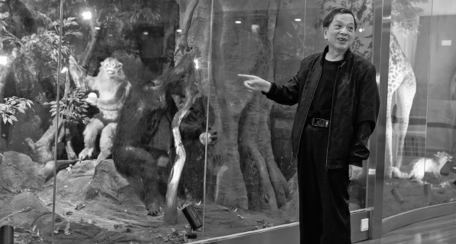Preserving the past to enrich the future
Taxidermist's vision allows the wonders of nature to be seen in the flesh, reports He Qi in Shanghai.

With more than 90,000 pieces of taxidermy and herbarium specimens, Zujia Biological Museum at Fudan University in Shanghai has become an important witness to the natural development and evolution of China's flora and fauna.
After opening up to the public in recent years, the museum, which has over 100 years of history, has gradually grown in popularity. This is also true of its specimen-defining scholars, the unsung heroes behind the precious collections. Tang Shimin, 70, has worked at the museum since 1982. He was eligible to retire 10 years ago and chose to come back to his post, accepting an offer by the university to return. He was simply not ready to say goodbye to the museum that his family have been fully devoted to for so long.
"Most of the stuffed animals in the museum were made by my family members," says Tang, the director of the taxidermy department at the museum.
The Tang family has a historical significance in the development of taxidermy in China, as their skills have been recognized as a provincial intangible cultural heritage.
Tang Shimin's ancestor Tang Chunying, a fisherman in Fujian province, learned taxidermy from British official T.D.D. La Touche, who worked at Fuzhou Customs in the 1860s.
He then coached other family members in learning the skill, growing a tree of outstanding taxidermists within the family. Today, more than 150 of them are engaged in the craft at top scientific research institutions, natural history museums and universities all over China.
Tang Shimin, the fifth-generation descendant of Tang Chunying, as well as the last taxidermist in the family, took over the taxidermy studio (the predecessor of the museum) in 1982 from his father. The studio has been run by Tang family since 1949.
"At first, I just felt that I couldn't let this skill go without a successor, but, later on, taxidermy became an indispensable part of my life," says Tang Shimin.
Covering all major categories of vertebrates, including mammals, birds, reptiles, amphibians and fish, the museum now has about 2,000 specimens on display and 5,000 teaching specimens.
For the first few decades, Tang Shimin was trying to collect rare animals to enhance the integrity and diversity of the collection, but he had to change his approach when the animal protection law was enacted in China in 1985.
"In the early 1980s, we were still able to hunt animals on farmland for taxidermy before the animal protection law came out," Tang Shimin says. "We also have giant panda in the museum that was made in the 1960s with a corpse donated by the Shanghai Zoo. But later, even donations of protected animals were not allowed.
"Half of the protected or endangered animals in the museum were collected through national animal research, but afterward, only animals that die due to disease, accident or natural causes can be used for taxidermy," he explains.
In the early 1990s, while searching for new materials at Shanghai Zoo, he found a binturong (often referred to as a bear cat) that had just died of illness. He quickly bought it from the zoo for 2,000 yuan ($280).
"I am so familiar with what animals the museum was missing, so I bought the binturong without hesitation," Tang Shimin recalls. He packed the peeled binturong skin in a burlap bag and rushed back to the university by bus with the help of a student.
To guarantee the best result, Tang Shimin finished the taxidermy process in three days.
What he didn't know was that it turned to be the last binturong Shanghai Zoo ever kept.
This is a rare and endangered animal in China.
Due to the Tang family's efforts, most kinds of animals have been preserved in the museum, including many endangered and extinct species in China, such as a Lipotes vexillifer (Chinese river dolphins) found in Nanjing, Jiangsu province, in 1964 and Rafetus swinhoei (Yangtze River turtle) found in Taihu Lake in 1950.
"Taxidermy is very helpful for our teaching, and is also important material for scientific research, especially for animals that have been around for a long time and are facing extinction," Tang Shimin says.
Nowadays, Tang Shimin's major duty has been shifted to preserve the integrity of taxidermy in the museum, as its collection is believed to cover all existing or known species. Despite regular spraying and pest control, taxidermy often spoils.
"Since large-sized or precious taxidermy is no longer able to be made (due to the animal protection law), my current job is to ensure the existing taxidermy lasts as long as possible while waiting for new materials. Then I make new exhibits, mainly to replace the damaged ones," Tang Shimin says.
In the museum, Tang Shimin has a refrigerator full of corpses of birds and small animals waiting to be taxidermied.
"I used to prefer not to taxidermy ordinary animals because they are common, but as I'm getting old, I hope to do as many as I can," he adds.
According to Tang Shimin, making a stuffed animal starts with skillfully dissecting the animal before using a wood and metal "skeleton" to shape the skin and filling it with straw, cotton and paper scraps using his family's unique "stuffing method".
Then they need to sew and stitch the animal's fur tightly. In this way, with the right technique, taxidermy can be preserved for decades, or even hundreds of years.
Tang Shimin says the taxidermy process, especially for larger exhibits is really quite laborious. For example, the camels and giraffes in the museum were handled by all the taxidermists in Tang family in Shanghai.
"The camel was made by nine people and the giraffe by six people," he says.
In his view, the life of animals is limited, and taxidermy can "record" their existence in another way.
After a period of renovation, the museum opened to the public for free in 2018. In 2019, the museum launched an online exhibition to further expand its influence, while protecting its precious animal specimens as much as possible, according to Wu Yanhua, the director of museum, who is also the senior lecturer of the School of Life Sciences at Fudan University.
Although Tang Shimin's offspring didn't follow the family tradition, Yan Jun, a postgraduate student majoring in zoology at Fudan University, became Tang Shimin's new apprentice and is expected to become the new "guardian" of the taxidermy museum.
"In the process of teaching how to make exhibits, Tang Shimin has always been unreserved, including paying attention to every detail," Yan says.
Like Tang Shimin, Yan hopes her efforts will educate more people.
"I want to use the museum and the faculty of Fudan University to carry out biodiversity-themed education for young people," she adds.





Today's Top News
- Crossing a milestone in the journey called Sinology
- China-Russia media forum held in Beijing
- Where mobility will drive China and the West
- HK community strongly supports Lai's conviction
- Japan paying high price for PM's rhetoric
- Japan's move to mislead public firmly opposed






























